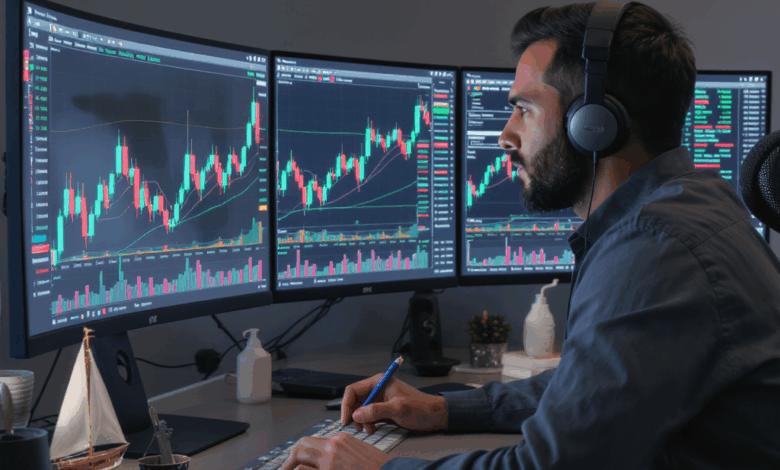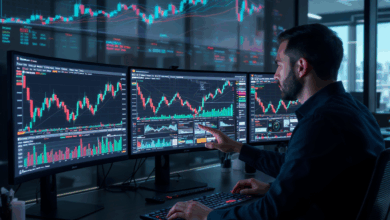Master Forex Trading Risk Management in 5 Practical Steps

Why do so many forex traders find themselves caught off guard by sudden market swings, despite having solid strategies? I remember my early days, watching the Indian rupee fluctuate wildly while trying to make sense of how to keep my trades safe. It felt like trying to sail a small boat through a storm without a compass.
This challenge isn’t unique. Since late 2024, the Reserve Bank of India has adopted a lighter touch on rupee intervention, allowing for broader daily price swings. Suddenly, what once seemed a predictable market became a rollercoaster. Small and mid-sized businesses began scrambling for ways to hedge their positions effectively, and individual traders like me had to rethink risk management entirely. Forward contracts surged, marking the highest usage in years, signaling a collective shift toward more proactive protection.
So, how can you, whether a novice or a seasoned trader, navigate this evolving landscape? The value of embracing robust risk management strategies cannot be overstated. By learning how to set thoughtful risk-reward ratios, employ stop-loss and take-profit orders, size your positions correctly, diversify trades, and manage leverage sensibly, you gain more than just control—you gain confidence.
In this guide, we’ll explore these five practical steps, blending recent market insights and tried-and-true tactics, to help you build a resilient trading approach. It’s not about eliminating risk—that’s impossible—but about understanding and managing it so that you can trade smarter, not just harder.
Are you ready to turn market volatility from a threat into an opportunity? Let’s embark on this journey together.
When the Rupee Dances Facing the New Reality of Forex Volatility
I still recall the uneasy feeling of watching the Indian rupee swing unpredictably during my early days in forex trading. It was as if the market had suddenly decided to rewrite its rules overnight. The Reserve Bank of India’s recent shift to a lighter hand in managing rupee volatility has only deepened this sense of unpredictability. Small and mid-sized businesses, along with individual traders, now find themselves navigating a more turbulent sea.
But what exactly does this mean for us—the traders and business folks trying to keep our footing? More than ever, it highlights the critical need for robust risk management strategies. The goal isn’t to eliminate risk—that’s an illusion—but to understand and handle it better.
Why Risk-Reward Ratio Matters More Than Ever
One of the first lessons I learned was the importance of setting a thoughtful risk-reward ratio. Think of it as your personal compass amid the storm. Aiming for a ratio of at least 1:2 means you’re willing to risk one unit to potentially gain two. This simple rule can help you stay afloat even if your trades don’t always win.
Isn’t it fascinating how such a straightforward idea can shape your entire approach? Recent insights from IG reinforce this, showing that traders who stick to disciplined risk-reward setups tend to weather volatility better.
Harnessing Stop-Loss and Take-Profit Orders Your Safety Nets
Imagine you’re sailing, and the seas get rough—you’d want safety nets to catch you if you fall. Stop-loss and take-profit orders serve this purpose. They automatically close your positions when certain price points are hit, protecting you from unexpected drops or locking in profits.
I remember a time when I hesitated to set these orders, fearing missed opportunities. But the market’s unpredictability often punished that hesitation. Experts at PipsWatch suggest these tools aren’t just for beginners—they’re essential for anyone serious about managing risk.
Position Sizing Balancing Ambition and Caution
How much should you put on the line in a single trade? Position sizing is where your risk tolerance meets your capital. Overcommitment can lead to devastating losses; too little might stifle meaningful gains.
By calculating position size relative to your account balance and risk appetite, you create a buffer against sudden market swings. This is particularly crucial with the RBI’s reduced intervention causing wider rupee fluctuations. Thaurus offers practical formulas and examples that can help tailor your position sizes smartly.
Diversification Not Putting All Your Eggs in One Basket
When volatility spikes, relying on a single currency pair feels like walking a tightrope without a safety net. Diversification spreads that risk across different pairs and strategies, softening the impact of any one unfavorable move.
This approach reminded me of investing stories where diversification prevented total losses during crises. Chinettiforex highlights how traders who diversify tend to experience less stress and more stable returns.
Leverage Management The Double-Edged Sword
Leverage can amplify profits but just as easily magnify losses. In times of heightened volatility, like we’re seeing with the rupee, cautious leverage use becomes imperative.
Choosing leverage levels aligned with your risk profile is not just prudent—it’s essential. I found that dialing back on leverage during uncertain times helped me stay in the game longer. UltimaMarkets offers excellent guidance on calibrating leverage wisely.
Staying Informed Your Early Warning System
Volatility doesn’t arise from a vacuum. Global economic indicators, central bank announcements, and geopolitical events often set the stage. Staying informed transforms you from a passive participant into an active navigator.
I’ve started integrating economic calendars and news feeds into my daily routine, giving me a heads-up on potential market-moving events. This proactive stance aligns with the increased hedging activity observed among Indian exporters and importers recently, as reported by Reuters.
Putting It All Together: Can You Try This Now?
So, where does this leave you? How do you move from knowing these strategies to actually applying them? Here’s a simple starter checklist:
- Assess your current risk-reward setups. Are you targeting at least twice the reward for each unit of risk?
- Implement stop-loss and take-profit orders on your open positions. Avoid trading without them.
- Calculate your ideal position size based on your account balance and acceptable risk. Adjust if necessary.
- Review your trading portfolio. Are you diversified across pairs and strategies?
- Evaluate your leverage usage. Is it aligned with current market volatility and your comfort level?
- Set up reliable sources of market news and economic indicators. Make it a habit to check daily.
Would you say these steps resonate with your current experience? Or do they highlight gaps you hadn’t noticed before? This is not the end but perhaps the start of a more mindful approach to forex trading.
What other strategies or experiences have helped you deal with unpredictable markets? I’d love to hear your thoughts as we continue to explore this challenging yet fascinating world together.

Reflecting on the journey we’ve taken through the shifting tides of forex trading, especially under the new rhythms of the Indian rupee’s volatility, it’s clear that mastering risk management isn’t about chasing certainty—it’s about embracing adaptability. We’ve seen how setting a disciplined risk-reward ratio, leveraging stop-loss and take-profit orders, sizing positions thoughtfully, diversifying trades, and managing leverage carefully all weave together into a resilient approach. This isn’t just a checklist; it’s a mindset that transforms unpredictable waves into navigable waters.
By internalizing these strategies, you’re not only safeguarding your capital but cultivating the confidence to engage with markets that seem to defy logic. The real value lies in this empowerment—the shift from reacting to market whims to steering your own course.
So, what can you do right now? Start by evaluating your current trades through the lens of these principles. Are your risk exposures aligned with your goals and comfort? Have you armed yourself with stop-loss orders that act as your safety nets? Could diversifying your portfolio ease the tension of sudden swings? Even small, deliberate adjustments can ripple into meaningful improvements.
Looking ahead, as global economic landscapes and central bank policies continue to evolve, the ability to manage risk thoughtfully will only grow in importance. Markets may never lose their volatility, but our strategies can grow ever more sophisticated and personal.
In the end, perhaps the most vital question isn’t whether we can predict the next storm, but how willing we are to learn the art of sailing through it. What steps will you take today to become a steadier navigator in your forex journey? Your next move might just mark the beginning of a new chapter in how you engage with the markets—and with uncertainty itself.





